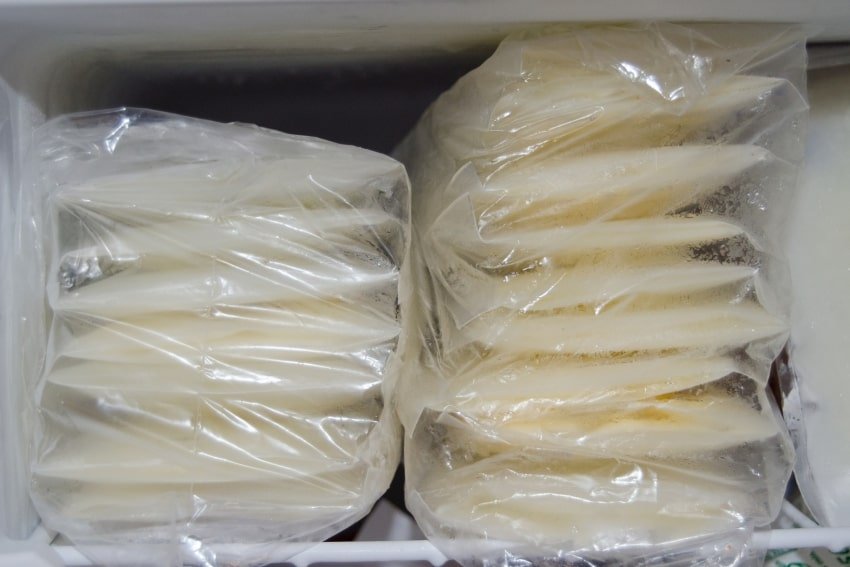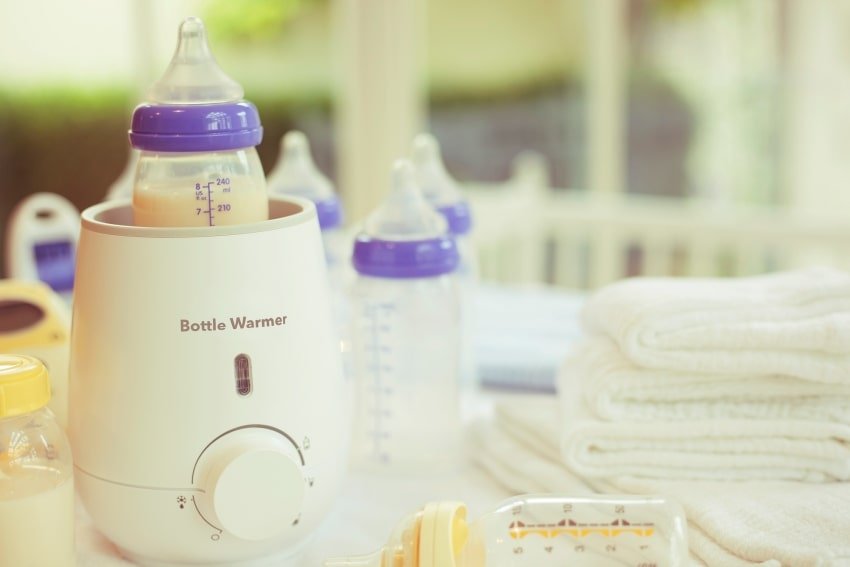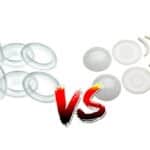Taking care of a baby does not come with a handbook, even though most of us wish that it did! One thing that we’re often concerned about is the temperature of our little one’s milk.
Too cold is said to cause an upset stomach, and too hot will burn our baby. It always is supposed to be just right, or is it? Research suggests that giving a baby cold milk will not upset their stomach.
In fact, babies can drink cold milk without any serious complications.
I’ve Given My Baby Cold Formula Before
When my daughter was little, she was a bit underweight coming home. I had to feed her at least two ounces, which took one hour. Then, I got an hour of sleep and woke up to do it all over again.
As a single mother, this was the definition of exhausting. There was one time, I simply forgot to warm her bottle. I was tired, and took it right out of the fridge and gave it to her. She drank it with no problems.
I called the doctor the next day and asked if it mattered. He insisted that if my daughter did not have a problem with drinking cold formula, there was nothing wrong with giving it to her cold.
I picked up a cooler to keep beside my bed and pre-made bottles for the night before laying down. Feeding her throughout the night suddenly became a little more convenient.
We did this until she no longer ate at night, which took several months because she was underweight ( I had to wake her up to feed her.) Throughout this time, she had no complications from drinking cold milk.
There Is No Medical Reason To Warm Milk
The claims that a cold bottle will upset the baby’s stomach or a warm bottle kills bacteria are nothing more than myths or theories.
As of right now, there is no medical reason to warm a baby’s bottle. It will not hurt a baby to drink a cold bottle any more than it will hurt them to drink a warm bottle.
Drinking Cold Milk Or Warm Milk Will Depend On Preference
Baby’s typically have a preference as to whether they prefer a warm or cold bottle.
Likewise, there are certain benefits to a baby drinking cold milk or warm milk that parents need to consider when deciding whether they are comfortable feeding their little one a cold bottle.
Cold Milk
Cold milk doesn’t necessarily mean icy cold. It can mean you left it to sit out on the countertop and it’s simply not room temperature yet.
View in gallery
A cold bottle might also be a pre-made one that is straight out of the fridge or cooler. There are key benefits to giving a baby cold milk, as well as a few drawbacks.
Pros
Giving Your Baby Chilled Milk Is More Convenient
Imagine never warming another bottle. Never hearing the way your little one screams as they impatiently wait for you to get done and feed them.
Instead, you simply grab a bottle out of the fridge and feed your little one. The simple convenience of a chilled bottle makes it sound a tiny bit appealing.
Cold Bottles Are Frugal Friendly, And Better For The Environment
When you heat a bottle using water on the stove, you are only using that water to heat a bottle. After that, it’s usually dumped down the drain.
Bottle warmers are expensive, and most use electricity to warm your bottle to the perfect temperature. You eliminate the excess electricity and water usage when you don’t have to warm a bottle anymore.
Chilled Bottles Wake Your Baby Up
When my daughter was younger, it was a challenge to feed her as much as she was supposed to eat. However, I was given a choice: make it happen or she would be in the ICU with a tube in her stomach because she had to gain weight.
The primary problem was keeping her awake. A chilled bottle was less soothing, and she was able to stay awake for longer periods of time to eat.
Cons
Cold Bottles Can Scare Babies
Babies are adjusted to certain things, which might include warm bottles. The sudden temperature change, or even the fact that the bottle is cold, can startle some babies. This can quickly turn into a negative association with feeding time.
Breastfed Babies Won’t Have The Consistency They Need With Feedings
When a baby drinks breastmilk from the breast, it is the same temperature as the mother’s body.
If you give your little one breastmilk from your breast one time, and a chilled bottle the next, your little one will not have consistency. This can lead to feeding problems.
You’ll Hear All The Old Wives Tales
It’s a common belief that giving a baby cold milk will give them an upset stomach, make them throw up, or simply make them sick and fussy.
Most people will try to help you by informing you of these things. If you continue to feed your baby cold bottles, the excessive advice can be tiring after so many months.
Warm Milk
Feeding your baby warm milk means that you are taking a few extra minutes to ensure that it is the right temperature. The most common temperature for warm milk is 98 degrees Fahrenheit.
View in gallery
It might be a little bit cooler, but if it’s warmer you run the risk of burning your baby. Consider these pros and cons if you would like to give your baby warm milk instead of having a baby drink cold milk.
Pros
Breastfed Babies Will Have Fewer Feeding Problems
When the temperature of the milk in a bottle is the same temperature as the breastmilk from the breast, babies are less likely to have feeding problems.
Breastfed babies already have a hard time adjusting to a bottle when they are used to a breast. Giving a baby cold milk can just add to those problems.
Feeding A Baby Warm Milk Is Relaxing
There is something about a warm bottle that is soothing to babies. It will help them sleep better, and fall asleep faster.
Babies are not known for getting startled by the chilly temperature, so you’ll never have to worry about your baby developing a negative association with feeding because of a bottle that was too cold either.
Other People Will Have Fewer Feeding Problems
Since babies are born, mothers are taught that the bottle should be warmed. Although this is optional, most people still warm their bottles.
Then, they test them on their wrist to make sure the temperature is appropriate for the baby. Finally, they feed them. This method has been used for years and continues to be the way that most people feed babies.
Once your baby begins to drink cold bottles, they might have feeding problems with other people, such as daycare workers or baby sitters. This is because they will be used to a cold bottle, and everyone else will warm their bottle.
Cons
Bottles Can Get Too Hot
While most people know not to use a microwave due to the increased risk of burning the baby with formula or milk that is too hot, that doesn’t mean that other methods are completely safe.
Bottle warmers can also heat bottles up to dangerous temperatures. Even heating a bottle in warm water can make the bottle too hot if the water is too hot. When your little one drinks a cold bottle, you’ll never have to worry about whether it’s too hot.
View in gallery
Your Baby Will Cry Longer As They Wait On You To Warm Their Bottle
When a baby has a need, it should be met as soon as possible. This helps infants develop a secure attachment to their caregiver.
The longer it takes to warm a bottle, the longer the little one is waiting on their need to be met. Usually, this isn’t a problem, but it is something to think about.
In the middle of the night, crying babies can wake up siblings and your significant other too. The entire house can get less rest because the baby is not sleeping through the night yet.
Granted, your little one will still cry if they wake up hungry, but being able to quickly pop a bottle in their mouth can drastically reduce the time they are crying.
Bottle Warmers Can Be Expensive
Warm water is a popular method for warming bottles, but bottle warmers are quickly taking over. These convenient gadgets can give you a perfectly warmed bottle in under a minute with the push of a button.
However, some of them can get rather pricey. I scoured Amazon and found one of the more affordable ones for you if you’re set on having a bottle warmer, but this is still an additional expense.
[amalinkspro type=”showcase” asin=”B082MN9SPZ” apilink=”https://www.amazon.com/dp/B082MN9SPZ?tag=mominformedcom-20&linkCode=osi&th=1&psc=1″ new-window=”true” addtocart=”false” nofollow=”true” sc-id=”4″ imgs=”LargeImage” link-imgs=”false” specs=”【5-in-1 MULTI FUNCTIONS】: Fast Warming /Sterilizing/Food Heating/Normal Warming / Defrosting/. This do-it-all machine deserves to be A Best Gift For Baby by growing families.~~~【Fast Warming in 3Mins】: A 240 ml milk bottle only takes 3 minutes to reach 40 ° C (104 ° F) from 4 ° C (39 ° F) ,Drink at any time to prevent the baby from crying . The bottle warmer will auto-shut off automatically when the milk is ready. Please take out the bottle in time to prevent overheat.Please refer to the data sheet of the manual to choose the amount of water for warm milk and set time” btn-color=”#ff9900″ btn-text=”Buy on Amazon” alignment=”aligncenter” hide-prime=”0″ hide-image=”0″ hide-price=”0″ hide-button=”0″ width=”750″]Bottle Warmer[/amalinkspro]
Can You Switch Your Baby To Drinking Cold Milk?
Yes, you can! Even your little one is used to drinking warm milk, and you want to switch over to cold bottles now that you know there is no medical reason to warm a bottle, you can work towards cold bottles so that you can enjoy the convenience.
It’s important not to suddenly give your baby a bottle fresh out of the fridge, though. If your little one is used to drinking warm bottles, this can be a shock to them, which can startle them. When babies are scared, they have more feeding problems.
Instead, it’s important to transition your little one slowly into drinking colder bottles. If you use a bottle warmer with a temperature setting, gradually reduce the temperature to make the bottle slightly colder.
You can do the same thing if you use warm water to heat the bottle. You can tell whether it is slightly colder or not by testing it on your wrist.
Transitioning a baby slowly to something new eliminates the problems that can come with making sudden changes that little ones are not prepared for.
Some Babies Will Refuse To Drink Cold Milk
While you can transition your little one to drinking cold milk, there are some babies that will not drink a cold bottle. Once they have adjusted to a certain temperature, it can seem impossible to transition them.
That’s okay though. Just like there is no medical reason to give a baby a warm bottle, there is also no medical reason to give a baby a cold bottle. It’s okay to go by your baby’s preferences when it comes to the temperature of their bottle.
For example, my first daughter never minded a cold bottle after the first one. It did not shock her. It never scared her. Because of that, I enjoyed the convenience that’s provided.
My son, and my grandson, were the opposite. They had and have very specific preferences pertaining to their bottle temperatures. A little too cold or too warm and they would both refuse to drink the bottle.
So, making sure the bottle was the right temperature took precedence. Remember, every baby is different.
Is It Okay To Give Babies Cold Milk?
Yes, it is perfectly fine to give your baby cold milk. Keep in mind what your baby’s preferences are. Carefully consider the pros and cons of both cold and warm milk when deciding if you would like to try to transition your baby over to drinking cold milk.
If you do decide to, there is nothing wrong with that! If not, that’s fine too! This decision is all about you and your baby, and, as always, you should do what is best for your little bundle of joy.






